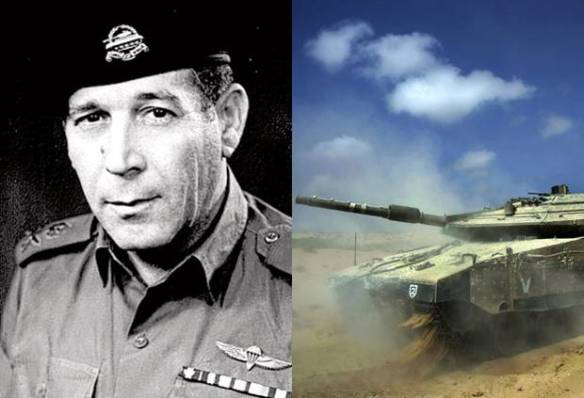Israel Tal, Israel Defense Forces (IDF) general and commander of its Armored Corps, April 21, 1966
Born: 1924 Israeli general and armor expert. Israel Tal (Talik) was born in 1924 on a Jewish kibbutz in Palestine. He joined the British Army, served with the Jewish Brigade, and saw action in the Western Desert during World War II. Mustered out of the service as a sergeant, he returned to Palestine and joined the Jewish covert military organization Haganah. In the 1956 Sinai Campaign he served as a brigade commander.
Tal took command of the Israel Defense Forces (IDF) Armored Corps in 1964 and immediately went to work to instill a new professionalism and discipline in that unit. The improved ability of the corps was important in the June 1967 Six-Day War, during which Tal commanded the armored Ugdah Division, the northernmost unit of the Israeli advance into the Sinai.
Tal’s division launched the Sinai attack on June 5, 1967, at the northern end of the main Egyptian defensive line, anchored at El Arish. Breaking through at Rafa and Khan Yunis within 12 hours, Tal’s success allowed Avraham Yoffe’s division to attack between Tal and Ariel Sharon’s forces deep into the Sinai. Tal ordered a separate armored task force to race ahead for the Suez Canal. The force arrived at the canal on June 7, making Tal the first to reach the waterway. Tal’s main force advanced on two axes toward Suez, including along the coastal road, while Yoffe and Sharon headed toward the Mitla Pass in hopes of trapping the Egyptian Army in the Sinai. Fending off desperate Egyptian counterattacks at Bir Gifgafa, Tal reached the canal across from Ismailia, and the IDF completed its conquest of the Sinai within four days.
In the aftermath of the Six-Day War and the War of Attrition (1968–1970), the IDF decided that the heavily fortified Bar-Lev Line was the best means for maintaining Israel’s hold on the Sinai. Tal, now the IDF vice chief of staff, strongly opposed the line’s strong point system, which he saw as an easy target for the Egyptian Army.
Having relied on purchased tanks for many years, in the 1970s the IDF decided to avoid the political winds of overseas tank acquisitions. Thus, the IDF asked Tal to head the design committee for the Merkava (Chariot) main battle tank.
After Tal’s retirement from the IDF, he served as assistant minister of defense from 1975 to 2000. He published a book, National Security: The Israeli Experience (2000), in which he recognized that the ability of the IDF to defend Israel rested on its ability to launch quick offensive strikes. Tal urged Israel to avoid defensive warfare and attrition while maintaining air superiority and the option of preemptive strikes to meet the future challenge of likely missile attacks.
References Bloom, Jeremy. Six Days: How the 1967 War Shaped the Middle East. New York: St. Martin’s, 2003. Herzog, Chaim. The Arab-Israeli Wars: War and Peace in the Middle East from the War of Independence to Lebanon. Westminster, MD: Random House, 1984. Oren, Michael B. Six Days of War: June 1967 and the Making of the Modern Middle East. Novato, CA: Presidio, 2003. Tal, Israel. National Security: The Israeli Experience. Translated by Martin Kett. Westport, CT: Praeger, 2000.
